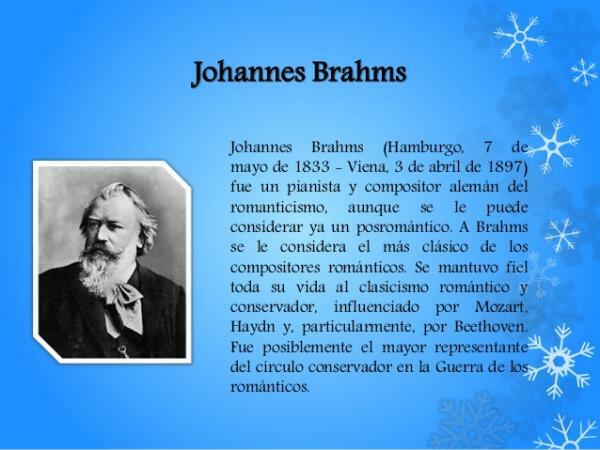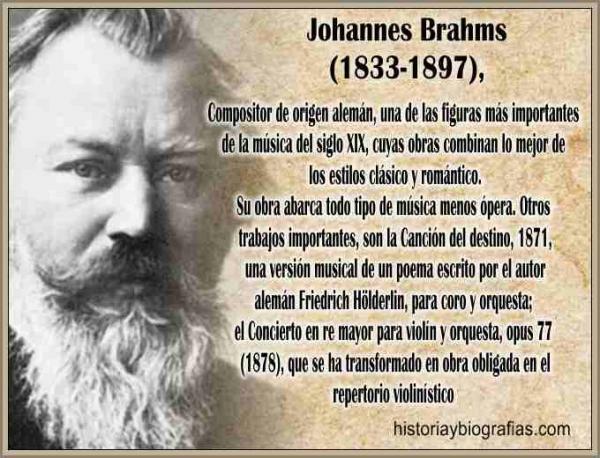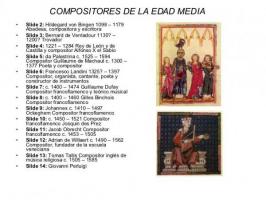The 10 best WORKS of Johannes BRAHMS

Image: Slideshare
The history of art and music is vast and full of characters who have populated the classical repertoire with works of great mastery. It is common that we hear the names of these people but sometimes we have not investigated enough to know them and appreciate his contribution to art. Could this be the case Johannes brahms, who is popularly known for the famous Lullaby that surely we have all heard at some time. In this lesson from a TEACHER you will know 10 of Brahms' best works and you can have an approach to the genius of this composer of the Romantic period.
Brahms was born in Germany in the 19th century, during the Romantic period and he was a virtuoso pianist and conductor, as well as a composer. He spent most of his life in Vienna and his great ability as a composer is recognized to the point of being grouped with Johann Sebastian Bach and Ludwig van Beethoven. It is the group of these 3 composers that is called "The 3 B’s of music" (Bach, Beethoven and Brahms).
He composed a wide variety of works including
symphonies, chamber music, pieces for piano, organ, voice and choir. Brahms was a perfectionist and it is said that only some of his works were published, as he himself destroyed those with which he was dissatisfied.Brahms is recognized for the quality of having a balanced between conservative and innovation, with a meticulous structure and romantic motifs. His compositions are, today, an essential part of the classical repertoire. In this other lesson we will discover other of the main composers of Romanticismor.

Image: History and Biographies
So that you better know the cultural and artistic legacy of this composer, we are going to discover you the 10 best works of Brahms. Here is a selection that will make you know the best of this prodigious musician.
Piano Sonata No.3 in F minor, Op.5 (1853)
It is Brahms' last piano sonata, composed when he was 20 years old in gratitude to the countess. Ida von Hohenthai, who got his brother Fritz Brahms a job as a music teacher. The sonata achieves an elegant mix between the romantic spirit and the classical structure, showing a clear influence of Beethoven, specifically in reference to his fifth symphony.
Piano Quartet No.2, Op.26 (1861)
Written for piano, violin, viola and cello. This work is an amalgamation between piano concerto and chamber music, of which the slow tempo movement stands out in genius. With a duration of approximately 50 min, it is Brahms's longest chamber work. The composer also made an arrangement of this work for a piano duo.
Trio for French Horn (1865)
Composed for horn (French horn), violin and piano. It is considered one of the best works written for the horn, making masterful use of the qualities of the horn, where Brahms demonstrates the deep understanding of him by the instrument. The work is a commemorative piece to Brahms' mother, who passed away earlier that year.
Die Mainacht (1868)
Another of Brahms's best works is this piece that is translated as "May night." It's a lieder (German song) that has a theme inspired by the moon on a May night. The beautiful landscape refers to someone who has been lost. It is a sensitive work of simple melody that gradually develops into drama.
Liebeslieder waltzes, Op. 52 (1868)
It translates as "love songs". They are a series of waltzes of 18 movements in total, for piano with four hands and voices in style Länder(an Austrian and German folk genre). It is said that in large part the inspiration for this work was Brahms' love for Clara Schumann (Robert Schumann's wife), romance that never blossomed.
Symphony No.1 (1876)
This is another of Brahms's best works, hands down. It is a majestic and mysterious work of which the fourth movement stands out. Some describe this symphony as dark, mystical, and complex. In this work you can notice the influence of Beethoven on Brahms and the reminiscence of German folklore.
Cello Sonata in F major, Op.99 (1886)
It is a work described as dynamic, heroic, imaginative and modern. Brahms wrote this work long after completing his first sonata, 20 years later to be precise. The work is written for cello and piano, and its structure has four movements: Allegro, affectionate adagio, allegro passionato and rondo.
Violin Sonata No.3 in D minor, Op. 108 (1887)
A work dedicated to a friend of Brahms. It highlights the fact that it is made up of 4 movements that fluctuate in expressiveness, in contrast to his previous violin sonatas that only contain 3 movements. Its structure: Allegro, adagio, a little quick and with feeling and quick agitato.
Quintet for clarinet in B minor, Op.115 (1891)
It has a masterful development that allows us to perceive this work as a journey from beginning to end. Dramatic in tone, it is described as a nostalgic and melancholic work of retrospection and farewell. It is made up of four movements and lasts approximately 35 minutes.
Sonata for Viola No.2 in E flat major, Op.120 (1894)
This sonata was originally written for clarinet but Brahms later adapted it to be played with the viola, since the instruments have a very similar register, varying only in the techniques that are they use.
Remember that these are just some of Brahms's works and while they are a good place to start getting to know this composer, there are many other wonderful options to discover.



